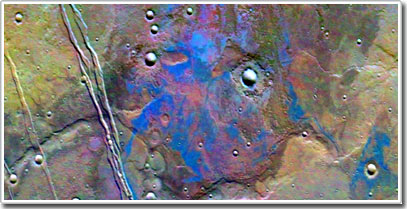Detecting salt deposits on Mars
US Aerospace Agency (NASA) on March 20 announced the Mars probe Mars Odyssey discovered evidence of salt sediments, dating back about 3.5 to 3.9 billion years, on Red planet, reinforcing the assumption that this planet might have life.
Xinhua News Agency reported that the research group led by University of Hawaii scientist Mikki Osterloo discovered traces of chloride minerals in about 200 locations spread over an area of 1 - 25 km 2 in the south. Fire.
Professor Philip Christensen of Arizona State University, a member of the research team, thinks that this mineral is most likely edible salt ( sodium chloride ). "This means there has been a lot of water and a source of energy, namely sunlight, on Mars," he said, BBC quoted. In addition to salt deposits, scientists also say there is much evidence that Mars has experienced a warm and wet climate, not as cold and dry as it is today.
The discovery of salt on Mars is thought to be an interesting discovery for the scientific world, because salt can preserve organic matter, so if there was life on Mars, just analyze these salt deposits. They will have answers to whether or not life on Red Planet.

Photographs from the Mars Odyssey show that there may be a chloride salt compound on Mars (blue zone)
MINH ANH
- The missing piece when conquering Mars is this white powder
- Little things to know about salt
- Salt water detected on Mars
- Video: Detecting the sign of Mars around the equator
- Discover the best location to search for life on Mars
- Sand dunes are leeches on Mars
- Reveal a very rare image of a giant snowfall in the Arctic of Mars
- There is no sea on Mars
- How to make pure white salt without scum, crispy delicious standard science
- Detecting aliens home on Mars?
- NASA confirmed that there was water flowing on Mars
- Detecting snow on Mars
 Van Allen's belt and evidence that the Apollo 11 mission to the Moon was myth
Van Allen's belt and evidence that the Apollo 11 mission to the Moon was myth The levels of civilization in the universe (Kardashev scale)
The levels of civilization in the universe (Kardashev scale) Today Mars, the sun and the Earth are aligned
Today Mars, the sun and the Earth are aligned The Amazon owner announced a secret plan to build a space base for thousands of people
The Amazon owner announced a secret plan to build a space base for thousands of people